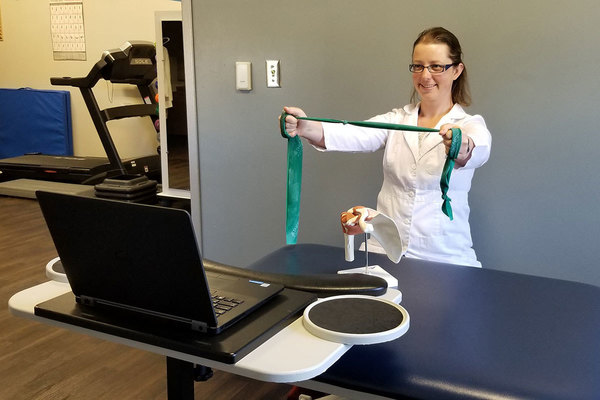

Despite the pandemic, the Wellness Center remains open for urgent, in-person care, but the vast majority of faculty and staff are attending appointments virtually to reduce the potential for transmission of the coronavirus. Nearly all services, including physical therapy, are available through video conferencing.
It may come as no surprise that many patients come for physical therapy after an injury or for rehabilitation after a surgery. In an initial consultation, which is the same virtually as in-person, physical therapist Bobby Rajkumar and his physical therapist colleagues, Dr. Ashley Mathis and Dr. Katelyn Linden conduct a full evaluation of their patients to assess their condition and set up treatment plans. They advise them how to have good posture and show them stretches that they can do to strengthen the muscles in their chest, for example.
As many faculty and staff are working from home, it’s important for them to have an ergonomic workstation. “A lot of people use laptops and lean over a laptop that is not meant to be used all day long,” Rajkumar says. “They are multitasking, looking down and are straining their neck or lower back. By keeping their bodies in an awkward position, they are putting a strain on the muscles in their back.”
“If, during the visit, I can see their workspace, I can give them recommendations on the proper placement of their monitor and keyboard, so their shoulders and elbows are in a healthy, ergonomic position.”
Physical therapy also plays a role in preventing injuries. “Prevention boils down to movement,” he explains. “When you put your body through a static posture for any period of time, your body conforms to that position.” Over a period of time, the muscles in front of the shoulders tighten and pull the shoulders forward while the back muscles stretch out and become weaker. The exercises he recommends stretch the tight muscles in the front and straighten the muscles in the back.
“The key is stretching every so often,” Rajkumar says. “Stretching, getting up, moving often. During the video call, we do a lot of exercises together, and I make sure they are using the correct form.” Afterward, he emails the patient the exercises that they should do at home to improve their condition.
Since the statewide ban on elective surgeries lifted on May 5, Rajkumar, Mathis and Linden, have seen an increase in the number of postoperative patients, but many patients started treatment before the pandemic began. After having rotator cuff surgery in January, Michael Sweikar, executive director of the Pulte Institute for Global Development, transitioned from in-person physical therapy to virtual sessions due to the pandemic. “My physical therapist, Ashley, did an excellent job adapting the therapy both in terms of explaining the exercises online and coming up with exercises that still worked for the equipment that I have, especially since I do not have all of the equipment at home that they do in the office,” he says. “Ashley even found ways to assess my shoulder’s mobility via video conference when we could not check mobility in-person.” Sweikar has progressively gained mobility and strength over the past few months while following the regimen that Mathis prescribed for him.
There are some unique advantages to virtual physical therapy. Giles Duffield, associate professor of biological sciences, had three virtual appointments with Rajkumar for a shoulder injury. “He was able to observe my exercises in real time, critique them and offer invaluable advice,” Duffield says. “This ensured that I was undertaking all exercises correctly, gave me the opportunity to ask important questions and provided the necessary confidence to progress alone.” Most importantly, during the visits Duffield was able to show his therapist the weights, stretch bands and other equipment he was using at home. “We made modifications to both how I conducted certain exercises, and how best to cycle through different sets.”
“Having the virtual visits take place every couple of weeks also gave me some additional motivation with a future time and date to focus on, so I made sure I did my exercises daily,” Duffield says. “I felt like I was getting the professional help I needed.”
Another patient, Marcy Oleck, who is a dependent of a staff member, appreciates how easily she can access the exercise program online. “Ashley did a wonderful job making sure I could see and understand everything she was explaining to me and each new exercise. She included pictures and videos of the exercises and stretches in my weekly program, as well as written descriptions of how to conduct each exercise,” she says. “She also included … tips and movements to stay away from.”
While there are numerous advantages to virtual physical therapy visits, particularly during a pandemic, Rajkumar believes that the only real limitation to the video visits is that therapists cannot feel the patient’s muscles to pinpoint the precise area of the body that is causing the discomfort.
“Video is never going to be able to replace a hands-on visit with a physical therapist,” he says. For now, video visits are the next best thing to an in-person visit, and typically achieve the same results. However, all patients — particularly those who are postoperative and those with acute injuries — are encouraged to consult with their physical therapist to determine which type of appointment is best for their situation.
View ergonomic tips for remote work including stretches to reduce fatigue and avoid injury, and meet the Wellness Center’s three physical therapists and other providers.
Originally published by at evp.nd.edu on May 26, 2020.